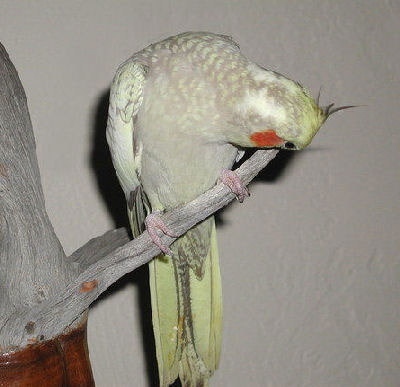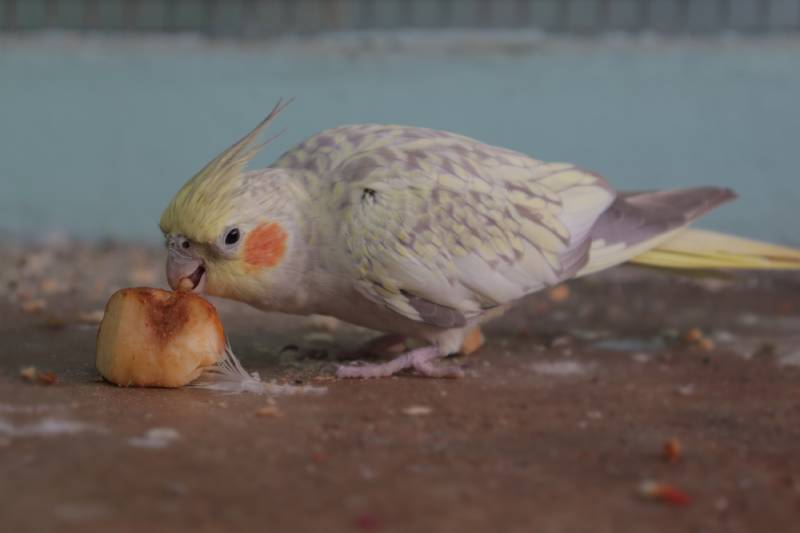
A Cinnamon Pearly Pied Cockatiel is quite a lot to say, but that huge mouthful describes a very pretty little bird!
The pretty Cinnamon Pearl Pied Cockatiel can be recognized by exploring its various color and pattern aspects. Starting with a Cinnamon Cockatiel you have a very warm colored bird lacking the cool greys found in the common Grey Cockatiel. A Cinnamon Pearl Cockatiel then has a ‘pearly’ pattern introduced to the cinnamon coloring. Finally adding a pied patterning on top of this, and you get a very pretty Cinnamon Pearl Pied Cockatiel.
Cockatiels are probably the most popular of the parrot family with their main competition being the Budgerigar (referred to as the Parakeet in the United States). They are hardy, easily handle changes in their home, and are easy to breed. On top of that, keeping a cockatiel as a pet is easy because they are not noisy parrots and they are comfortable when left alone for long periods of time.
Cockatiels are considered parrots as can be seen by the shape of their beak. They are members of the Cockatoo family which is apparent by their cute little erectile crests. Unlike cockatoos however, they have long tails making up about half of their total length, and giving them more of a parakeet type appearance.
Cockatiel’s evolved as nomadic creatures, surviving in a variety of diverse and rugged habitats. They are constantly on the move, changing locations with the seasonal fluctuations of food and water supplies. This native habitat and their adaptive behavior has made them well suited as pets.
For more information about the care of Cockatiels see:
Guide to a Happy, Healthy Cockatiel
- Kingdom: Animalia
- Phylum: Chordata
- Class: Aves
- Order: Psittaciformes
- Family: Cacatuidae
- Genus: Nymphicus
- Species: hollandicus
Scientific Name
Distribution
The Cinnamon Pearl PIed Cockatiel is a strain developed by breeders and is not seen in the wild. Grey cockatiels are found over most of Australia except the coastal areas and most of Tasmania. Tasmania, an island state of Australia, has many of the parrots found in Australia but the cockatiel is not present there. It is thought that though they are one of Australia’s fastest flyers, their flying strength is apparently not sufficient to help them bridge the waterway that separates the island from the Australian mainland.
Description
Cockatiels are considered parrots, as can be seen by the shape of their beak. Cockatiels are probably the most popular of the parrot family. They are closely related to the Cockatoos, and like Cockatoos they are members of the Cacatuidae family.
As members of the Cacatuidae family they too have an erectile crests. This cute little crest will be held erect when they are stimulated and excited, flattened when they are feeling angry, defensive, or submissive, and somewhere in between when they are in their normal ‘hanging out’ state. Unlike the other members of this family, however, they have long tails. The tail makes up about half of their total length and gives them more of a parakeet type appearance.
The overall plumage color of the Cinnamon Pearl Cockatiel is a combination of cinnamon brown and yellow. Cinnamon’s lack the cool gray found in the common Grey Cockatiel, and they can be any intensity cinnamon from a light tannish-grey to a chocolate brown. They have a gene that effects the melanin pigment, it actually stops the brown pigment from changing to grey or black.
The genes that create patterning, such as the pearling or the pied patterns, does not have any visual affect on coloring but rather affects the distribution of the coloring. Pearling is where the feathers on the back, nape, and wings are edged or laced in yellow. (This would be white edged on birds with grey coloring.)
The Cinnamon Pearl Pied Cockatiel is much the same as the Cinnamon Pearl, but with a random pied patterning added to the mix. The pied affect is a striking combination of yellows and cinnamons in a random pattern. (This would be combinations of whites and greys on grey colored birds.) The amount and placement of the colors vary widely from one bird to the next.
See descriptions of sexual differences for this pet bird cockatiel below, under the breeding cockatiels section.
Size – Weight
These birds get up to 12 inches (30 cm) and weigh 3 to 4 ounces.
Care and feeding
Good sized bird cages are a must for good cockatiel care. A roomy cockatiel cage is required unless the bird is to be let out for extended periods. Many birds can spend most of their time on a playpen or parrot perch. Bird food consists of a variety of sprouts, seeds, nuts, fruits, vegetables, and commercial pellets.
See About Cockatiels: Care and Feeding for more information.
Social Behaviors
Cockatiels travel in flocks in the wild and this influences cockatiel behavior in captivity. Their social ‘flock’ disposition along with their native habitat makes them well suited as pets. They are hardy, adapt easily to change, and are easy to breed. A big plus is that cockatiels are not noisy and can be left alone for long periods of time. They make a very loving and devoted pet if bonded properly.
For taming cockatiels and cockatiel training, see About Cockatiels: Handling and Training.
Activities
Common bird activities for cockatiels, they like to climb and play. Cockatiel bird care includes providing lots of bird toys and excercise. Give them plenty of time outside the cage if possible, a playpen works well for this. Many cockatiels can learn to talk and whistle, especially the males.
See About Cockatiels: Activities for more information.
Breeding/Reproduction
Cockatiel breeding can be a very rewarding experience. Cockatiels will readily nest provided they have a nest box and some material to construct the nest from. They lay one egg every other day until they have laid about 5 eggs. The incubation period is 17 – 22 days. After hatching the young birds will open their eyes at 9 days of age.
This is a good time to start hand feeding if you don’t want to incubate the eggs yourself. Incubation and raising the chicks yourself requires dedication since the young chicks will need feedings every two hours for the first couple of weeks. Likewise, you can pull them from the nest earlier than 9 days, but with greater risk to the chick and greater effort on your part with frequent feedings. After about 18 days the orange cheek patch will appear on the babies. At about 30 days they will look like adult birds, and will fledge at about 35 days of age.
For more information on cockatiel breeding, see About Cockatiels: Breeding/Reproduction.
Sexual differences
There are a lot of opinions about how to sex cockatiels, but with many of the color varieties they are usually just indicators, and not certain ways to tell. The Grey Cockatiel is dimorphic, meaning it can usually be visually sexed at about six months of age.
A DNA test is always the best way to know what sex your pet is for sure, but there are a couple other clues for a sexing a Cinnamon Pearl Cockatiel and a Cinnamon Pearl Pied Cockatiel.
- Coloring:The coloring of any Cinnamon Cockatiel is of very limited help. The yellows on the face of a female are more abundant than on a common Grey female, but the amount of yellow is about the same for both types of males.
- Pearl Patterning:
For a Cinnamon Pearl Cockatiel, the pearl patterning is the best clue to determining the sexes visually. However this is only possible after the first molt at about six months. A female will retain the pearl patterning. however the pearling will be mostly lost on a male. Though the pearl pattern will not actually be totally gone on a male, it be so faded that it will not be very difficult if not impossible to see. - Pied Patterning:For the Cinnamon Pearl Pied Cockatiel, the pied patterning gives no indication of sexual differences. It is best to look at its pearl patterning and coloring, as described above.
Potential Problems
The cockatiel health is easy to maintain as these are very hardy birds, but for all pet birds there are potential problems For optimum bird health care for your cockatiel, it is good to know what signs of illness to be aware of.
For information about cockatiel health, see About Cockatiels: Problems.
Availability
The Cinnamon Pearl Cockatiel and the Cinnamon Pearl Pied Cockatiel are somewhat less available cockatiels for sale than a straight Cinnamon Cockatiel, but they can be readily found with a diligent search. There are also lots of Grey Cockatiels as well as other different colored mutations readily available including lutino and white-faced varieties.
Featured Image Credit: Barbara Rost, Shutterstock
